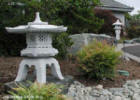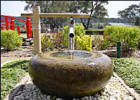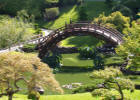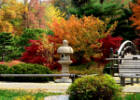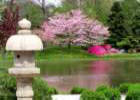-
Water Features (Waterfall or Pond)
-
Waterfall - Ponds and waterfalls are typical in Japanese gardens. They add life movement and a soothing sound to the garden space.
-
Pond - Considered to be the heart of a garden to traditional Japanese. A small pond is just as effective a a larger one. It should be
complimentary to the other features in the garden.
-
Islands - They represent life in the garden. They can be a simple rock or a more elegant mound made from rock and dirt of with plants can be
planted. With larger islands, a bridge can be a connection from it to the main garden area.
-
Rocks - Represent living things such as mountains. They can also be designed to afford a meditation focal point in the garden. They are usually
grouped in threes or uneven numbers to avoid symmetry. The ancient gardeners of Japan came up with four categories of rocks: tall and thin, large and squat, arching and
flat.
-
Paths - An important purpose of a Japanese garden is for it to be looked at and enjoyed. A path allows easy access to areas of the garden. The
sound that a path makes when stepped on is also important. Referring back to ancient Japan, the different sounds that were present were important. This has been incorporated into the
design of Japanese gardens and it helps to set the garden apart from the rest of the world.
-
Plants - One of the most important part of a Japanese garden is plants. They should be placed in such a way that they look natural. They should
compliment each other and not overcrowded with too many plants. Landscape plants act as a cohesion for the entire garden. Plants of a traditional Japanese garden vary from Maples to
Ferns, Camellias and Azaleas.
-
Ornaments - Most of the ornaments found in Japanese gardens originated with a useful purpose. Stone lanterns were used to light a path.
Waterbowls, to wash hands before going into the team rooms or temples. Some stone towers have religious meanings.
-
